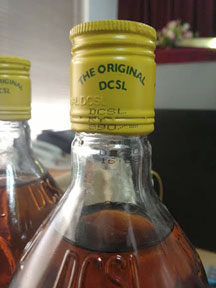Excise dept puts tight lid on alcohol adulteration
By Kurulu Kariyakarawana
Adulterating a consumer item is a common issue that could be noticed
in any developed market. To make impure by adding extraneous, improper
and inferior ingredients to gain more profit from consumer goods such as
food and beverages is a punishable offence in every country.
Adulterating milk with water in poorer nations in Asia as well as
adulterating hamburgers with horse meat in leading retailers in the UK
are examples that it could happen anywhere. Like regular consuming items
liquor or alcoholic beverages are also subjected to various adulteration
in Sri Lanka.
|

Deputy Excise Commissioner (Crimes)
Wasantha Dissanayake |
Adulteration of alcohol even has a history of five to six decades
following the introduction of legal distribution and sale of liquor
products in the country in early 1900s. Since the establishment of Sri
Lanka Excise Department in 1913 systematic methods were adopted to
control the illicit sale of liquor products and adulteration.
Adulterated alcoholic beverages are legal alcoholic products that have
been illicitly tampered with by diluting them with water, purposely fill
them in new containers to conceal their true origin or quality, or to
add toxic substances to manipulate the qualities.
Habits
A large number of persons die annually due to alcoholism or excessive
and unhealthy drinking habits. Out of this a considerable number of
individuals die of consuming substandard and illicitly manufactured
alcoholic beverages. And some die due to alcohol poisoning which could
be as a result of consuming adulterated liquor products. Especially
adding toxic substances such as Methanol could cause poisoning. Methanol
is deliberately added to liquor products by illegal manufactures as a
cheap substitute to Ethanol. In clean fermentation process Methanol is
produced in very low levels but in unclean fermentation process it could
be produced in high levels, which is highly toxic and could end up in
death also.
Methanol
Alcohol poisoning could also show symptoms of abdominal pains,
diarrhoea, nausea, vomiting, dizziness, headache or weakness, breathing
difficulty or shortness of breath, seizures and sometimes blurred vision
or blindness.
Adulteration of alcoholic products suddenly became the talk of the
town with the recent detection made by the Excise Department in Hatton.
A special team from Excise Head Office in Colombo raided a wine store in
Upcot area and recovered 120 DCSL Extra Special arrack bottles that had
been adulterated with water. The Excise on information conducted raids
on two previous occasions but failed until they gave a surprise raid on
the third time.
The strength or the alcohol volume of an adulterated bottle was 26%
whereas the strength of an actual bottle of Extra Special should be
33.5%. It was learnt that the illegal traders have made five adulterated
bottles out of single bottle of absolute arrack.
|

The data printed on the seal of the lid |
Adulteration of licensed liquor products is a common offence that
could happen anywhere. The perpetrators will simply remove the lid of a
sealed tight bottle and empty half of the liquor and refill it with
water. They will then fix a new lid to the bottle with the seal intact
and sell. This was the common practice for a long time. But with this
recent detection the officers who conducted the raid were bewildered by
the methods used by the perpetrators to carry out the adulteration
process. As an additional security feature the DCSL have printed the
name of the company, the price and certain other data on the lid and on
the bottle neck by using a computerised printer. Although one could
tamper the seal of the lid and replace it with a new one, it is
impossible for them to reprint the data.
Adulterated
All the seized adulterated bottles contained not only the safety seal
intact but the printing on the lid and the bottleneck as well. The
officers are yet to ascertain how the perpetrators have managed to do
this. However they believe that whether the traders have used extreme
methods such as heating the lid of the bottle to expand it and open and
replacing it the same way having the printed letters intact.
Deputy Excise Commissioner in charge of Crimes Wasantha Dissanayake
told the Sunday Observer that it is after a long time that they detected
such adulterated liquor products since adulteration takes place very
seldom nowadays. Unlike several decades ago there are a large number of
liquor manufacturing companies in the country which has created a huge
competition amongst the brands. Since there is a variety of brands there
is a wide range of prices from which the consumers could select.
If certain product is increasing its price the customers could always
switch to a different cheaper brand and the sales of liquor shop owners
would still remain uninterrupted. This was a different scenario when
there were only very few brands sometime back. The illicit products
recovered from the Upcot wine store was confiscated whereas a fine of
Rs.2.6 million was imposed on the owner. Adulteration of liquor product
is an offence according to the Excise Ordinance of 1913.
It is categorised as a Technical Crime Report (TCR) or a type of
crime that violates Excise license. All Excise license violations come
under the purview of Excise Commissioner General. Unlike other serious
crimes like production or possession of illicit liquor or plantation and
possession of Ganja that could be produced in a court of law all the
license violations are dealt according to the provisions stated in the
Excise Ordinance.
Violations
Excise license violations can be imposed under various amounts of
fines that starts from Rs.1, 500 and even up to several million rupees.
A massive fine of Rs.30 million was imposed on a private distillery in
Hanwella in 2010 for violating the Excise laws of not maintaining the
same stocks declared to the department.
In 2013 the revenue earned by the government through the department
from fines was at Rs.97, 725, 254 (Rs.97million). The department had
carried out 32, 881 detections countrywide and out of that 6, 415 were
TCR cases. Excise Department is considered to be the third highest
revenue generator in the country next to Department of Inland Revenue
and Department of Customs. It is also the third highest revenue
generator in the Ministry of Finance. With the increasing number of
detections every year and tightening of fines the department warns of
stern action against adulteration of alcohol products that could lead to
untimely deaths and breaking the trust of customers in quality products. |

